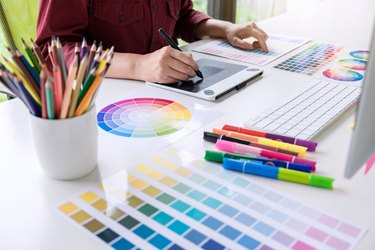
To unblur a picture or image in Microsoft Paint, several features are useful. Some pictures are only slightly blurred and corrections make a big improvement while others are beyond repair in Paint and require a much more powerful program to remove a blur. Paint is free, which is nice, and a suite of other online photo and image editing programs also exist to complement Paint if needed.
Sharpen the Image
Video of the Day
The first step to clear up text, images and photos is the sharpen function. This is an all-around great tool that helps create a clean, crisp final product. To sharpen an entire image, locate the primary toolbar and click on Effects followed by Picture. Lastly, choose to Sharpen the image and select OK to finalize.
Video of the Day
Don't worry if the result is not what you desired. You can always undo the last step and remove the sharpening while restoring the original image. Sharpening is a great method of reducing blur and making small corrections in an image. It will not, however, remove extreme blurring and is best used for basic tasks and touch-ups.
Another method of working the sharpening feature to fix blurry pictures is through the Unsharp Mask method. First, duplicate the layer and click the Adjust option on the duplicate. This saves the original image to ensure a backup copy is set up and ready for a different approach. The adjust box offers multiple features, including the unsharp mask, clipping and radius tools. You can clip away overly blurred sections, adjust the edges and use the unsharp mask slider to help unblur the image.
Take your time and find the best balance before saving the final image on the duplicate layer. Use a new name for the image to ensure it does not attempt to replace the original image file.
Effects and Noise Reduction
Sharpening helps but noise reduction can really clear up an image. Again, the tools here are not ideal for extreme cases and intentionally blurred photos, but they can make significant improvements for minor blurring issues. The tools are also very easy to access and use while walking back corrections through the undo function as needed.
Use the Effects tab and locate the noise reduction feature. Open the noise reduction dialogue box and adjust the slider while watching the photo transform. Most photos have a sweet spot where the noise reduction hits a visually attractive point. Too little or too much, however, and the photo won't look natural.
Play with the sliders until the photo shows the maximum reduction in blur. This is not an exact science and requires some time and possibly several outside opinions to agree on the right amount of noise reduction and sharpening to effectively unblur a picture.
Alternative Editing Options
Paint is a great program for basic edits and it also has the perk of being free. That said, unblurring images is best done with more advanced editing programs like Adobe Photoshop. A host of other online tools exist as well with many offering free services. GIMP is a popular photo editing program that offers a similar group of tools as Paint, while Photoshop requires a purchase for access.
Also consider attempting a simple web search for an unblur image program. Many free programs focus specifically on unblurring pictures. Unblur photo apps like Snapseed will even complete the task right on your phone without any advanced image steps requires. An app of this nature is efficient and effective for quickly unblurring photos.